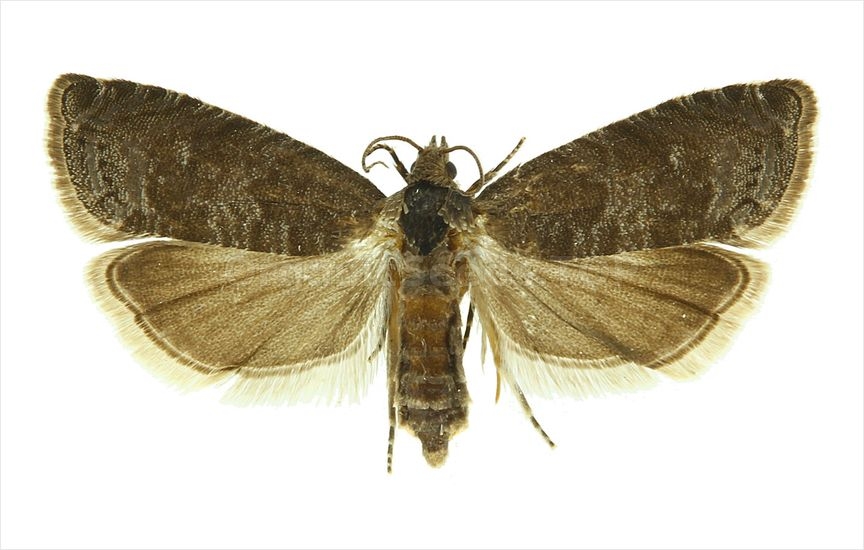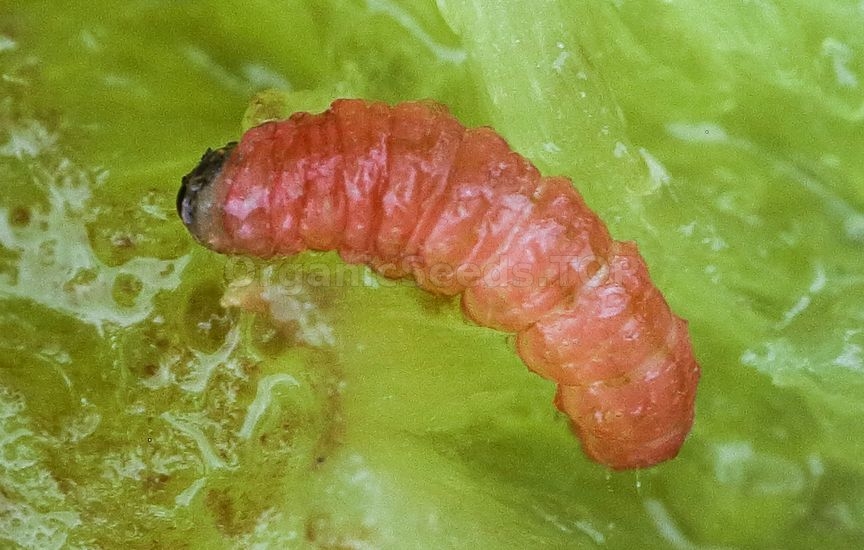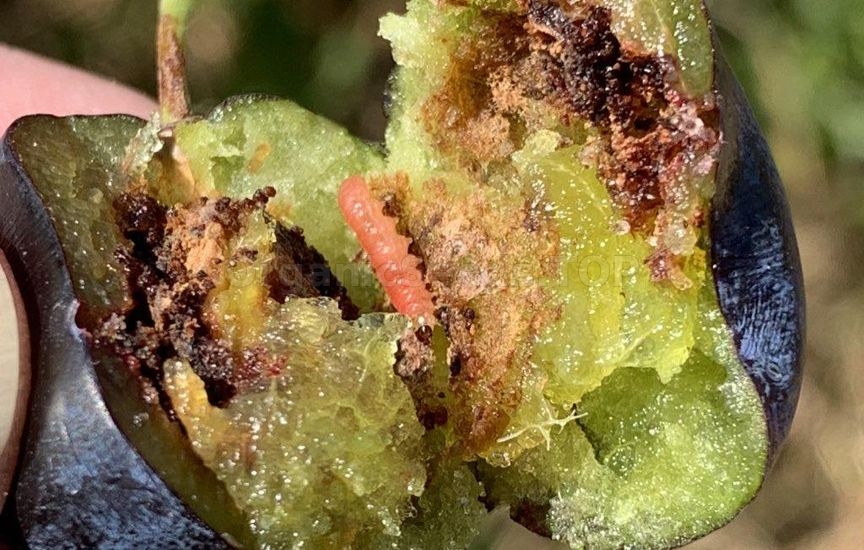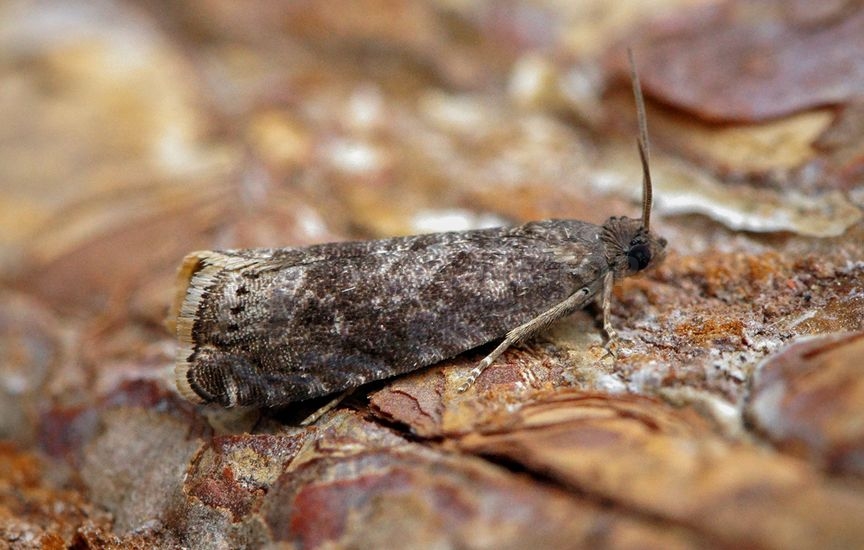Plum moth - «Grapholita funebrana» |
 The plum moth - is a pest of plums, sloe, cherry plum, peach, and rarely of cherries. Caterpillars feed on the pulp of fruits, destroying and polluting them with their excrement. Damaged fruits ripen prematurely and fall off. Reproduction is bisexual. Caterpillars overwinter in a dense cobweb cocoon. They develop in 2-3 generations, depending on the climate of the area of residence. MorphologyImago
Grayish-brown moth. Length 5-8 mm. Wingspan - 14-17 mm. The front wings are dark brown-gray with a purple tint. The outer edge of the wing has a lighter stripe. The hind wings are single-colored, light brown, with fringe along the outer edge. The length of the costal margin of the fore wing does not exceed 7 mm.  Sexual dimophrism As with all leafrollers, different-sex individuals differ in the structure of their genitalia. In the abdomen of the male plum moth, tufts of long androconial scales are visible on the sides between the eighth and ninth segments. The seventh sternite of the female's abdomen in the middle part does not have a separate area. In addition, on the hind wing of the male, all the scales are fringed with sharp-toothed tips. The copulatory opening in the female genitalia is located above the sclerotized plate. Egg Round, translucent, greenish-white. Larva The body is pink-red, the head is dark brown. Length - 12-15 mm. Under the anal shield there is a small anal ridge with 3-6 spines. On the anterior chest in front of the spiracles, the middle of the three adjacent setae is located slightly below the outer ones. At an older age, the caterpillar turns red. On the soles of the abdominal legs, some adjacent hooks differ in size, this is especially noticeable on the inside of the leg. On the tergites of the abdominal segments, between the setae, there is one pair of bald spots - small spots devoid of spines, covering the remaining surface of the segment. Pupa Like all representatives of the leafroller family, the pupa belongs to the primitive, incomplete type, and moves out of the cocoon when the butterfly emerges. From the abdominal segments, the fourth, fifth and sixth are mobile in females, and the fourth and seventh in males. Almost all abdominal tergites bear two rows of sharp spines directed backwards. With their help, the pupa moves out of the cocoon.  DevelopmentImago
The beginning of butterfly summer is observed with a set of effective temperatures of 105-120°C with a development threshold of +10°C. The mass flight occurs 12-15 days after the appearance of the first butterflies. The average calendar period of mass summer is the third ten days of May in the south of Ukraine and the beginning of June in the forest-steppe zone and Polesie. Mating period The years are stretched out. In the south of Ukraine it lasts from 35 to 50 days. Females lay eggs mainly on the fruits of the food plant, less often on the leaves, placing them on the less illuminated sides, often from below. Egg laying is observed in the evening when the ambient temperature is not lower than 14-15°C. The fertility of females ranges on average from 40-50 to 40-85 eggs. When the temperature drops to + 12-13°C, egg laying stops. The optimal temperature for these processes is + 24-26°C. Females lay eggs one at a time, sometimes 2-5 for each fruit. Egg Embryo development ends in 4-11 days. Larva The revival coincides with the formation of stones in fruits of late varieties at a sum of effective temperatures (above 10°C) of 190-200°C. The caterpillar emerges from the outside of the egg and crawls along the fruit for some time - from several minutes to several hours. In the chosen place, she weaves a net from the web and under it bites into the fruit. The larva does not eat the bitten off pieces, but puts them aside, and later closes the entrance with them. Droplets of gum are released from damaged areas, which harden in the form of droplets and streams. In the pulp, the caterpillar makes its way to the cutting. It reaches it 3-5 days after penetrating the fetus, after which it chews through the vascular system and disrupts the flow of nutrients. If there are fruits nearby, the caterpillars can move from one to another. Having finished feeding, the caterpillars remain inside for no more than a day. Larvae of younger instars develop in fruits over a longer period of time. Insects leave the fruit through an exit hole with a diameter of up to 3 mm; after the caterpillar leaves, this hole remains free of excrement. The duration of development of caterpillars in fruits ranges from 17 to 30 days. In areas of woodland and northern forest-steppe, the emergence of caterpillars from fruits begins in July, and most of them remain for the winter. Not all first generation larvae pupate. Partially (from 25 to 55%) they enter diapause and remain in this state until the spring of next year. In the south of Ukraine, caterpillars leave fruits in the first ten days of June, and in mid-June they pupate in the top layer of soil at a depth of 5 cm. Cocoons can be found in plant debris, in the bark of trunks and branches. Pupa In the spring, overwintered caterpillars pupate. The process begins 10-15 days after the start of the growing season. This coincides with the bud release phase of late plum varieties. The duration of the stage is from 15 to 27 days. Caterpillars that have not entered diapause pupate and develop into butterflies already this year.  Abiotic factorsThe years and development of the pest are extended. Therefore, caterpillars feed on fruits in August and September. In the south of Ukraine, the third generation is optional. In warm climates, one generation develops in 26-35 days; in areas with full development of two generations, development takes from 35-40 to 50-55 days.
The plum moth damages plums, sloe, cherry plum, peach, and rarely cherries. Harmful at the larval (caterpillar) stage. The pest gnaws through the vascular system, as a result of which the flow of nutrients to the fetus is disrupted. Damaged fruits stop growing, turn purple, ripen prematurely and fall off. In young fruits, the caterpillars also damage unhardened seeds; in more mature ones, they gnaw out a cavity in the pulp around the seed, which is filled with excrement.
You may need:«Plum moth» trapPheromone trapsGlue trap (single adhesive cardboard) 205x125 mm |
|
|
